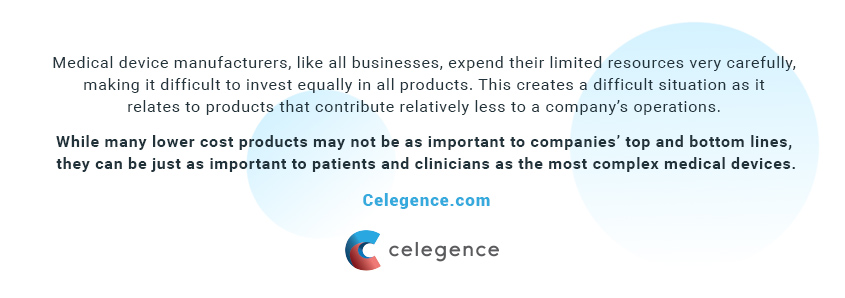This is the seventh in a series of blogs related to some of the key challenges being encountered to the recent updates to EU MDR.
The New EU MDR Guidelines
The new EU MDR guidelines will involve a lengthy EU MDR checklist including an array of topics, ranging from general administrative information to verification and validation, amongst others. One of the most important changes associated with the transition to EU MDR involves the Clinical Evaluation (MEDDEV 2.7.1). The benchmark standard required to demonstrate continued safety and performance of subject device(s) have increased as compared to Medical Device Directive (MDD). Under existing regulations, manufacturers have multiple options to demonstrate the safety and performance of their products. Ideally, the source of this information is from manufacturer-sponsored Clinical Studies and or peer-reviewed literature that explicitly studies the subject device. These data sources provide the most direct evidence in support of a device and, as such, are viewed as the gold standard.
Notified Body Requirements
Given the size and scope of the medical device industry, manufacturers are responsible for supporting a wide variety of products. Some of the products are more complex and have relatively low sales volume with high cost, often sold on a system level. On the other end of the spectrum, are products that are used much more frequently with much lower unit costs. While these devices vary quite extensively with respect to metrics such as price, sales volume, and physical dimensions, they’re not viewed differently in the eyes of Notified Bodies. In this context, a Notified Body would apply the same review standards across all ranges of devices.
Regulatory Challenges for Medical Device Manufacturers
Medical device manufacturers, like all businesses, expend their limited resources very carefully, making it difficult to invest equally in all products. This creates a difficult situation as it relates to products that contribute relatively less to a company’s operations. While many low cost products may not be as important to companies’ top and bottom lines, they can be just as important to patients and clinicians as the most complex medical devices. Unfortunately, a manufacturer’s business needs can make investments in trials and other forms of investigation for lower cost products a challenge. When clinical data is unavailable, a sponsor might leverage equivalent and or similar device(s) to demonstrate adequacy of safety and performance data for the subject device. In the ideal setting, a sponsor could use another one of its own products to establish equivalence to the subject device if available. However, there are instances in which the equivalent device is made by a different manufacturer. Establishing equivalence in such cases can be extremely difficult. Given that thorough demonstration of equivalence requires access to current technical documentation. Clearly, competing manufacturers will not agree to share technical data with each other, for a variety of reasons. Per new EU MDR guidelines, competing manufacturers should have a formal agreement for claiming equivalence to each other’s device. Completion of the agreement will allow one manufacturer to have ongoing access to the other manufacturer’s technical documentation. Convincing a competing manufacturer to enter into such an agreement could be extremely difficult and might come with a monetary cost and concerns regarding intellectual property. If the equivalence pathway is not feasible, manufacturers still have a few options available to them under the MDD.
Options for Demonstrating Equivalence
Safety of a device can be demonstrated through Post-Market Surveillance (PMS) data, especially for legacy devices that have been CE Marked for many years, preferably a decade or longer, with low complaint rates. Limited product recalls, corrective and preventive actions (CAPAs), field safety corrective actions (FSCAs) etc. can further support the established safety profile of a medical device. This strategy is less desirable compared to the use of clinical data or equivalence but was worth exploring under the MDD framework. If, after exhausting all available options, manufacturers are still unable to provide adequate clinical data to demonstrate their product safety and performance for their intended use, they will generally be asked to design a post-market clinical follow-up (PMCF) study. As opposed to Post-Market Surveillance (PMS), which is considered both passive and retrospective, PMCF is viewed as a form of active and prospective surveillance. Because of the costs and uncertainty involved, it is in a sponsor’s best interest to justify the ability to withhold PMCF for a given subject device(s).
Increase in the Number of CE-Marked Products Requiring a PMCF
With the EU MDR regulations, it is anticipated that sponsors will experience an increase in the number of CE-Marked products for which a PMCF is required. Requiring manufacturers to undertake a PMCF puts them in a challenging position. PMCF studies will involve investments in terms of finance and resources and if PMCF conducted by the manufacturer is disapproved by the Notified Body, it is possible that a given product will fail to obtain its recertification, potentially jeopardizing its market access. As a result, manufacturers may decide that it is in their best interest to not pursue recertification for certain products. Hopefully, this will occur most frequently in the context of product families, for which a manufacturer will have some continued product offerings even after select products lose market access. With stringent requirements set in the new regulations and the manufacturers’ reluctance to undertake PMCF studies, the EU MDR could result in fewer options for patients needing treatment with medical devices. It is likely that manufacturers will prioritize their more costly devices while streamlining their offerings of less expensive products. This could result in fewer treatment options for patients across a wide spectrum of disease conditions. It is common for less expensive products to be sold in families such that there are many individual devices used to treat similar conditions. While devices in the same family tend to be similar, they are not necessarily identical. If such product families are made smaller as a result of new regulations, it could impact availability of the medical devices for patients and health professionals.
With guidance from an experienced team of medical writers and regulatory affairs specialists, sponsors may find ways to reduce the number of products they decide to pull from commercial markets.

